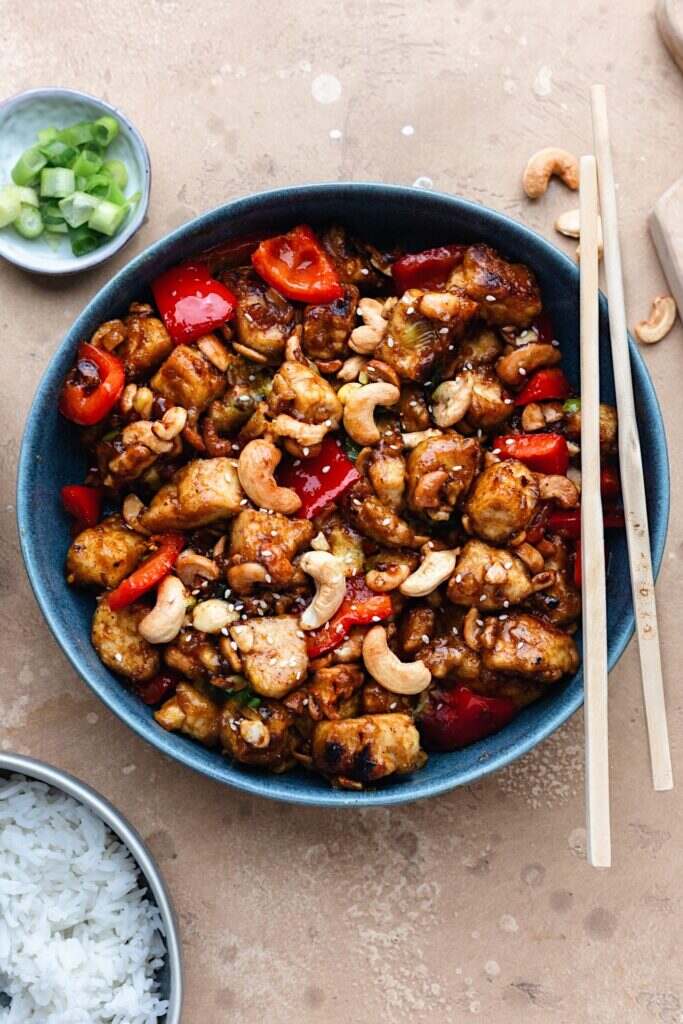Soya Chunks Cashew Stir-Fry is a delightful and nutritious dish that combines the goodness of protein-rich soya chunks with the crunchiness of cashew nuts and a colorful assortment of vegetables. This stir-fry dish is bursting with flavor, thanks to the combination of garlic, ginger, soy sauce, and chili sauce. It’s a versatile recipe that can be easily customized with your favorite vegetables and spices, making it a popular choice for vegetarians and those seeking a wholesome meal option. Whether served as a standalone dish or paired with rice or noodles, Soya Chunks Cashew Stir-Fry is sure to satisfy your taste buds with its delicious blend of textures and flavors.
| Ingredients | |
| 1 | 1 cup soya chunks |
| 2 | 1/2 cup cashew nuts |
| 3 | 1 onion, sliced |
| 4 | 1 bell pepper, sliced (any color) |
| 5 | 1 carrot, sliced |
| 6 | 1 cup broccoli florets |
| 7 | 2-3 cloves garlic, minced |
| 8 | 1-inch ginger, minced |
| 9 | 2 tablespoons soy sauce |
| 10 | 1 tablespoon chili sauce (adjust according to spice preference) |
| 11 | 1 tablespoon vinegar |
| 12 | 1 tablespoon oil |
| 13 | Salt and pepper to taste |
| 14 | Spring onions for garnish (optional) |
Step-by-step cooking instruction of Soya Chunks Cashew Stir-Fry:
Step-1 Prepare Soya Chunks: Start by soaking the soya chunks in hot water for about 15-20 minutes or as per the package instructions. Once they are soft, squeeze out excess water and set aside.
Step-2 Toast Cashews: In a dry skillet, toast the cashew nuts until they turn golden brown. Keep them aside.
Step-3 Stir-fry: Heat oil in a pan or wok over medium-high heat. Add the minced ginger and garlic, and cook for one minute, or until fragrant.
Step-4 Add Vegetables: Add sliced onions, bell peppers, carrots, and broccoli florets. Stir-fry the vegetables for a few minutes until they become crisp and slightly tender.
Step-5 Add Soya Chunks: Now, add the soaked and drained soya chunks to the pan. Stir-fry for another 2-3 minutes.
Step-6 Seasoning: Add soy sauce, chili sauce, vinegar, salt, and pepper. Until everything is equally coated, thoroughly mix.
Step-7 Finish: Toss in the toasted cashew nuts and mix them with the vegetables and soya chunks. Cook for another minute or two.
Step-8 Garnish and Serve: Garnish with chopped spring onions if desired. Serve hot as a main course or with rice or noodles.
Nutritional values of Soya Chunks Cashew Stir-Fry:
The nutritional value of Soya Chunks Cashew Stir-Fry can vary depending on the specific ingredients and proportions used in the recipe. However, here’s a general overview of the nutritional benefits you can expect from this dish:
| 1 | Protein: Soya chunks are an excellent source of plant-based protein, providing all the essential amino acids necessary for building and repairing tissues in the body. The dish’s protein level is further enhanced by the cashew nuts. |
| 2 | Fiber: Vegetables such as onions, bell peppers, carrots, and broccoli are rich in dietary fiber, which aids in digestion, promotes satiety, and helps regulate blood sugar levels. |
| 3 | Healthy Fats: Cashew nuts are high in healthy fats, primarily monounsaturated and polyunsaturated fats, which are beneficial for heart health when consumed in moderation. |
| 4 | Vitamins and Minerals: This stir-fry typically contains a variety of vegetables, each contributing its unique array of vitamins and minerals. For example, bell peppers are rich in vitamin C, while carrots are high in vitamin A and broccoli provides vitamin K and folate. |
| 5 | Low in Saturated Fat and Cholesterol: Since this dish is primarily plant-based, it tends to be low in saturated fat and cholesterol, making it a heart-healthy option. |
| 6 | Calories: The calorie content of Soya Chunks Cashew Stir-Fry will depend on factors such as portion size and the amount of oil used in cooking. However, it generally provides a moderate amount of calories, making it suitable for a balanced meal. |
Background History of Soya Chunks Cashew Stir-Fry
The history of Soya Chunks Cashew Stir-Fry is rooted in the culinary traditions of various cultures, particularly those that have embraced plant-based diets and diverse stir-fry cooking techniques.
Soya Chunks (Textured Vegetable Protein): Soya chunks, also known as textured vegetable protein (TVP) or textured soy protein (TSP), have been used for decades as a meat substitute in vegetarian and vegan cooking. Textured soy products were developed as early as the 1960s, primarily to address the need for affordable and nutritious protein sources, particularly in countries where meat consumption was limited or expensive.
Cashew Nuts: Cashew nuts, native to Brazil, have a long history of culinary use in various parts of the world. They are rich in nutrients and healthy fats, making them a popular ingredient in vegetarian and vegan dishes, as well as in traditional cuisines such as Indian, Thai, and Chinese.
Stir-Fry Cooking: Stir-frying is a cooking technique that originated in China over 1,500 years ago. It involves cooking ingredients quickly in a small amount of oil over high heat, typically in a wok. Stir-frying allows for the retention of the natural flavors, colors, and nutrients of the ingredients while imparting a delightful charred aroma and texture.
The combination of soya chunks and cashew nuts in a stir-fry likely emerged as a way to create a satisfying and nutritious vegetarian dish with a balance of protein, healthy fats, and vegetables. Over time, variations of this dish have evolved in different culinary traditions, incorporating local ingredients and flavor profiles.
Today, Soya Chunks Cashew Stir-Fry is enjoyed by people around the world as a delicious and wholesome meal option that caters to various dietary preferences and requirements, including vegetarian, vegan, and gluten-free diets. Its popularity continues to grow as people seek flavorful and nutritious alternatives to traditional meat-based dishes.
| Advantages of Soya Chunks Cashew Stir-Fry | |
| 1 | High Protein Content: Soya chunks are an excellent source of plant-based protein, making this stir-fry a satisfying option for vegetarians and vegans looking to meet their protein needs. |
| 2 | Nutrient-Rich: The dish contains a variety of vegetables and cashew nuts, providing essential vitamins, minerals, and antioxidants necessary for overall health and well-being. |
| 3 | Versatility: Soya Chunks Cashew Stir-Fry is highly adaptable, allowing for customization with different vegetables, spices, and sauces based on personal preferences and dietary requirements. |
| 4 | Heart Health: Cashew nuts contribute healthy fats, particularly monounsaturated fats, which may help improve heart health when consumed in moderation. |
| 5 | Fiber-Rich: The inclusion of vegetables adds dietary fiber to the dish, which aids digestion, promotes satiety, and helps regulate blood sugar levels. |
| Quick and Easy to Prepare: Stir-fry dishes are typically quick to cook, making Soya Chunks Cashew Stir-Fry a convenient option for busy weeknights or when you need a nutritious meal in a hurry. |
| Disadvantages of Soya Chunks Cashew Stir-Fry | |
| 1 | Allergies: Some individuals may have allergies to soy or nuts, such as cashews. It’s important to be mindful of potential allergens when preparing this dish, especially if serving to guests or family members with known allergies. |
| 2 | High Calorie Content: Depending on the amount of oil and nuts used in cooking, Soya Chunks Cashew Stir-Fry can be relatively high in calories. Portion control is crucial, particularly if you’re watching your caloric intake. |
| 3 | Sodium Content: One staple of stir-fry recipes is soy sauce, which has a lot of sodium. Excessive sodium intake may contribute to high blood pressure and other health issues, so it’s advisable to use low-sodium soy sauce or limit the amount used in the recipe. |
| 4 | Potential Overcooking: Overcooking the vegetables or soya chunks can result in a loss of nutrients and a less desirable texture. It’s essential to cook the ingredients just until they’re tender-crisp to preserve their nutritional value and flavor. |
| 5 | Not Suitable for Nut-Free Diets: The inclusion of cashew nuts makes this dish unsuitable for individuals with nut allergies or those following a nut-free diet. |
Compare with Similar meal of Soya Chunks Cashew Stir-Fry:
Similar meals to Soya Chunks Cashew Stir-Fry include other stir-fry dishes that feature a combination of protein-rich ingredients, vegetables, and nuts or seeds. Here are a few examples:
| 1 | Tofu and Vegetable Stir-Fry: Substitute tofu for soya chunks in a stir-fry with a mix of colorful vegetables such as bell peppers, broccoli, carrots, and snap peas. Toss in some cashew nuts or sesame seeds for added crunch. |
| 2 | Quinoa Stir-Fry with Mixed Vegetables: Cooked quinoa makes a nutritious base for a stir-fry dish. Combine it with an assortment of vegetables like mushrooms, spinach, zucchini, and bell peppers. Add some cooked chickpeas or edamame for protein and texture. |
| 3 | Tempeh and Cashew Stir-Fry: Tempeh, a fermented soy product, is another excellent protein source for stir-fries. Marinate tempeh slices in soy sauce and ginger, then stir-fry with vegetables like bok choy, snow peas, carrots, and mushrooms. Toss in cashew nuts for extra flavor and crunch. |
| 4 | Vegetable and Peanut Stir-Fry: Create a flavorful stir-fry sauce using peanut butter, soy sauce, garlic, and chili flakes. Stir-fry a mix of vegetables such as broccoli, bell peppers, cabbage, and snow peas, and add cooked chickpeas or tofu for protein. Garnish with chopped peanuts for added texture. |
| 5 | Cashew Chicken Stir-Fry: For a non-vegetarian option, replace the soya chunks with bite-sized pieces of chicken breast or thigh meat. Stir-fry with vegetables like bell peppers, onions, carrots, and broccoli, and add cashew nuts for crunch. For a savory taste, season with ginger, garlic, and soy sauce. |
Mostly questions asked about Soya Chunks Cashew Stir-Fry
1: What are soya chunks?
A: Soya chunks, also known as textured vegetable protein (TVP) or textured soy protein (TSP), are a meat substitute made from defatted soy flour. They are often used in vegetarian and vegan cooking for their high protein content and meat-like texture.
2: Are soya chunks healthy?
A: Yes, soya chunks are considered a healthy food choice as they are low in fat, rich in protein, and contain essential nutrients such as iron, calcium, and B vitamins. They are also a wonderful source of dietary fiber and free of cholesterol.
3: How should soy chunks be prepared for cooking?
A: Soya chunks typically need to be soaked in hot water for about 15-20 minutes to rehydrate them before cooking. After soaking, squeeze out excess water and they are ready to be used in recipes like stir-fries, curries, or stews.
4: Can I substitute soya chunks with tofu?
A: Yes, tofu can be used as a substitute for soya chunks in recipes like stir-fries. Both tofu and soya chunks are high in protein and can be seasoned and cooked in a similar manner.
5: Are cashew nuts good for health?
A: Cashew nuts are nutrient-dense and contain healthy fats, protein, vitamins, and minerals such as magnesium, zinc, and iron. They are beneficial for heart health, weight management, and overall well-being when consumed in moderation.
6: Can I make this dish without cashew nuts?
A: Yes, you can omit cashew nuts from the recipe if you have allergies or dietary preferences. The dish will still be flavorful and nutritious with the combination of soya chunks and vegetables.
7: What vegetables can I use in this stir-fry?
A: You can use a variety of vegetables in Soya Chunks Cashew Stir-Fry, such as onions, bell peppers, carrots, broccoli, snap peas, mushrooms, and cabbage. Feel free to customize the recipe with your favorite vegetables or whatever you have on hand.
8: Is this dish suitable for vegans?
A: Yes, Soya Chunks Cashew Stir-Fry is suitable for vegans as it does not contain any animal products. It is made with plant-based ingredients like soya chunks, vegetables, and cashew nuts.
9: How spicy is this dish?
A: The spiciness of the dish can be adjusted according to personal preference. You can control the level of spiciness by adjusting the amount of chili sauce or omitting it altogether if you prefer a milder flavor.
10: Can I prepare this meal in advance?
A: Yes, you can prepare Soya Chunks Cashew Stir-Fry ahead of time and store it in an airtight container in the refrigerator for up to 2-3 days. To serve, just zap it in the microwave or on a pan.







